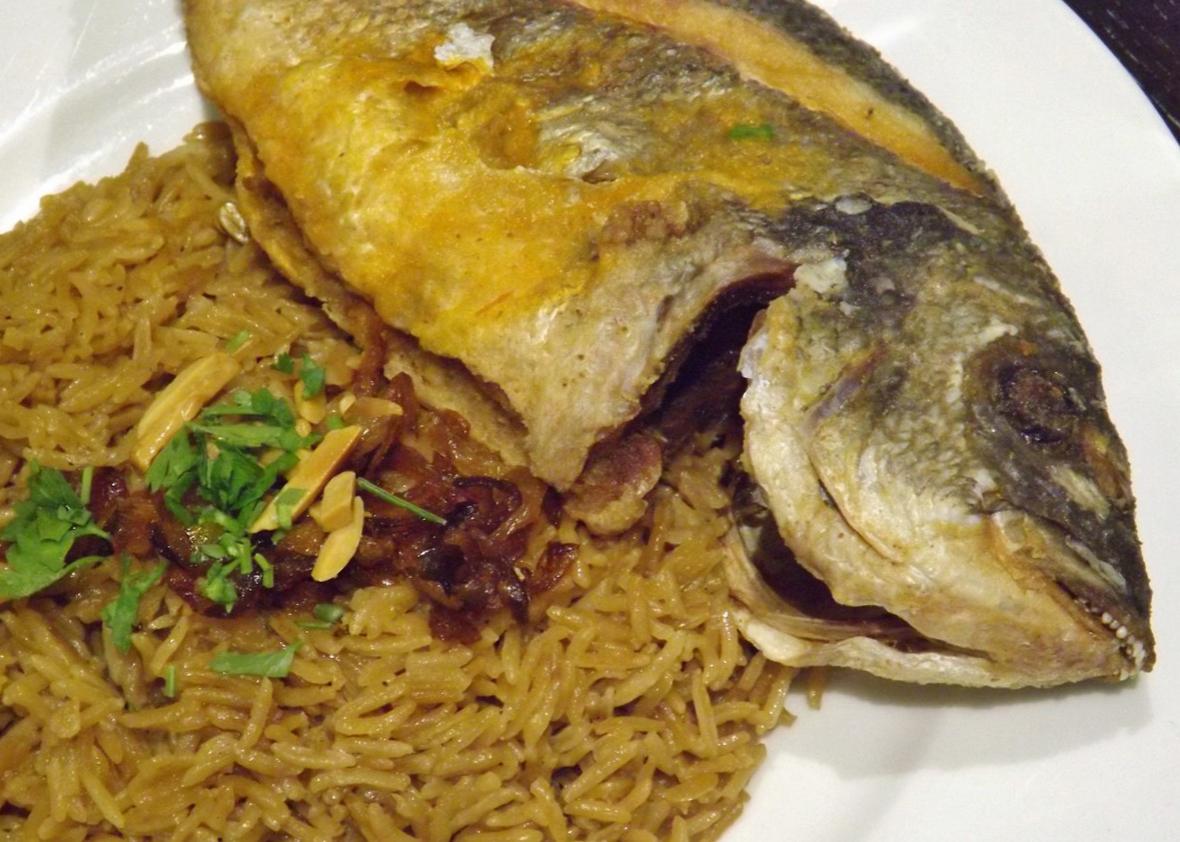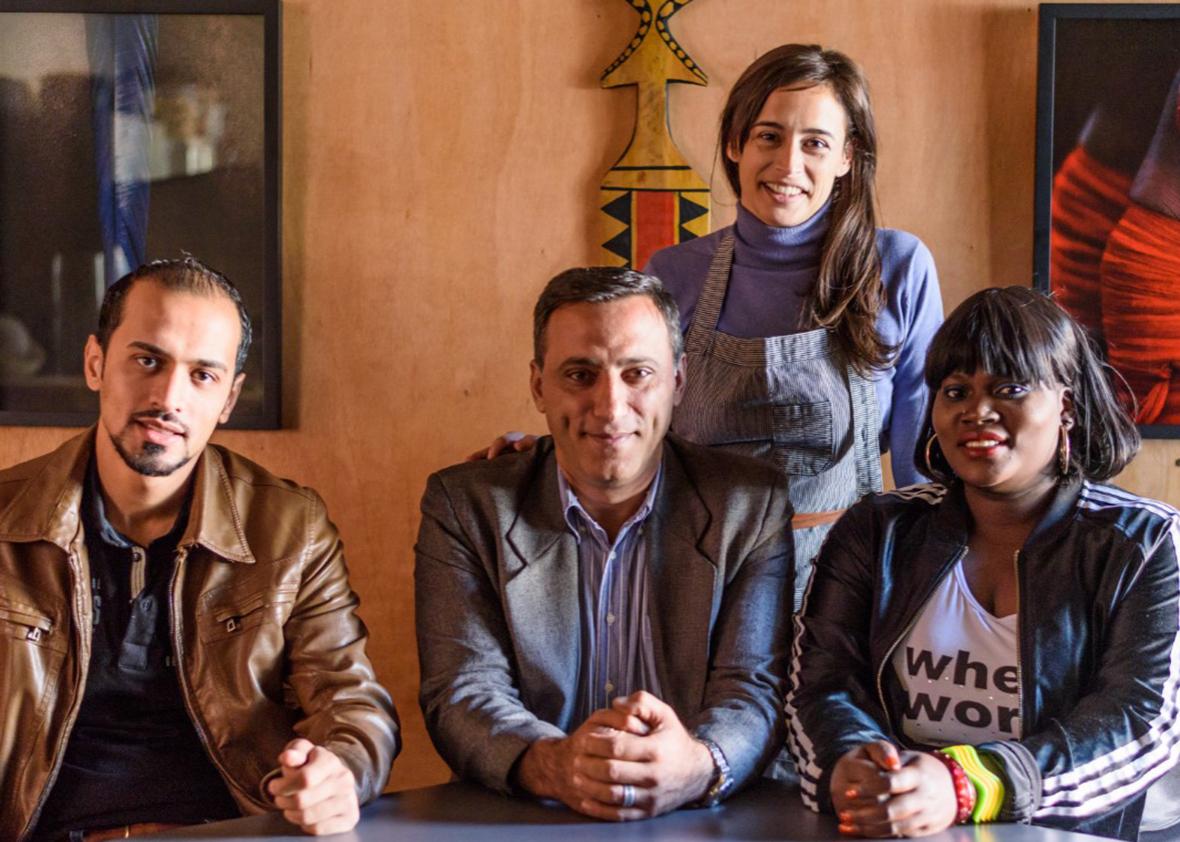Each week, Roads & Kingdoms and Slate publish a new dispatch from around the globe. For more foreign correspondence mixed with food, war, travel, and photography, visit its online magazine or follow @roadskingdoms on Twitter.
Mazen Zwawe is putting the final touches on his new food stand in the Rota 94 Food Park on Frei Caneca Street in downtown São Paulo. A small sign stuck to the side of the stainless-steel cart reads “Chef Mazen Zwawe, Middle Eastern cuisine—buffet, parties and events,” but Zwawe isn’t quite satisfied. “The sticker guy did the wrong thing, right on my opening day. Now he has to change it. Oh, well,” he says.
This stand is the fourth commercial venture that Zwawe has opened in São Paulo in as many years, but the first, he says, that will show “what authentic Syrian cuisine really is.” He’d opened his previous stand inside a bakery in the industrial district of Brás, just east of downtown. “I used to do the recipes that people here are more familiar with, like falafel, kebab, sfihas, and kibbehs,” he says. “If it were up to me, I would do only my favorite Syrian recipes, like Sayadieh, a fish with spiced rice and caramelized onions.” In his new location, culturally vibrant and surrounded by universities, that’s just what he plans to do, cooking food that will show, he says, “what the authentic Syrian cuisine really is.”
He holds up a laminated menu illustrated with amateur photos, each dish described in Portuguese, riddled with the small errors of someone still learning a new tongue. There’s sujok, pita bread with spiced ground beef, tomatoes, and garlic, and muhammara, a Syrian hot pepper dip originally from Aleppo. At his previous place, he says, “people didn’t value this food.” This time, he’s confident things will be different.
Brazil—and São Paulo in particular—has always been a magnet for immigrants. The country’s commercial capital and largest city is home to the highest concentration of Japanese people outside Japan and, along with neighboring Argentina, one of the largest Italian communities outside of Italy. In the early 20th century, Syrians and Lebanese fleeing the Ottoman Empire came to Brazil by ship, docking at the port city of Santos, about 60 miles from São Paulo, and coming inland to settle in the city.
Immigration is central to Brazil’s cultural identity, but even given this rich history, the number of immigrants now appearing on Brazil’s shores is unprecedented. In the past five years, the total number of requests for refuge in the country has increased by more than 2,868 percent, from 966 requests in 2010 to 28,670 in 2015. Two years ago, the Brazilian government passed an ordinance that would streamline the visa process for Syrian refugees. Since then, Syrians have been arriving in record numbers and granted refuge at higher rates than in Europe or the U.S. According to CONARE, Brazil’s national council for refugees, there were, by April of last year, 8,863 recognized refugees in the country of 79 different nationalities, with Syrians representing nearly 26 percent of the total. All of them, one can imagine, will be looking for a taste of home.

Young Shanahan
Zwawe came to Brazil as a refugee in 2013 after his restaurant in Damascus was destroyed in a bombing. He arrived with just $100 in his pocket and started peddling his dishes at food festivals until he made enough money to rent a stand. Much of the food he saw labeled as Syrian, he says, wasn’t Syrian at all. It was, instead, a mixture of Lebanese, Armenian, and Syrian: a “confusion” of cuisines (to use Zwawe’s term) that Paulistanos described simply as “Arabic food.”
“Lebanese food is not the same as Syrian, just as Syrian cuisine is not the same as Moroccan. Each has its own particularities,” Zwawe says. “Luckily, Brazilians are usually open to new flavors.” He indicated the stands on either side of his new one there on Rua Frei Caneca: one specializing in Colombian arepas, the other selling Bolivian salteñas. “We have food here to fit all tastes.”
As is the case for newly arrived immigrant communities in cities across the world, many of the refugees currently pouring into Brazil speak not a word of of the local language, Portuguese. By opening food businesses, refugees can capitalize on Paulistanos’ taste for Middle Eastern cooking and their hunger for new flavors in a setting where language skills aren’t strictly necessary. Many of these refugees were medical doctors, engineers, and accountants back home in Syria. Others had already worked as chefs or bakers. Now they earn their daily bread by making it. And though “Arabic food” has been a part of São Paulo’s culinary landscape for a century, dishes like those featured on Zwawe’s menu have begun a new wave of more authentic Middle Eastern—and particularly Syrian—food in the city.
The first recorded Syrian immigrants in São Paulo came in 1880. They settled in the city’s downtown, where rents were cheap, where markets were within easy reach, and where previous waves of Arabic-speaking immigrants had already established themselves. By then, São Paulo was well on its way to development, a process that only accelerated with a post–World War I construction boom that gave the city its first tall buildings and tram lines.
As they had no capital to buy land and saw little economic prospect in rural labor, many of those early Syrian immigrants opted to open businesses, hoping for rapid financial returns and the opportunity to work independently. Many dedicated themselves to clothing and fabric stores while others started cooking and selling Syrian food, catering to the tastes of their fellow countrymen. Those with more resources—sometimes from Syria, but often from Lebanon or Armenia—opened the first restaurants specializing in Middle Eastern dishes. Though initially these restaurants catered to other immigrants, they soon became mainstays on the city’s culinary map. Today, sfihas, baba ganoush, hummus, fattoush, and labneh are as essential to São Paulo as pizza or temaki.
The latest wave of immigrants and refugees has come for reasons similar to those that drove their predecessors, but they’ve arrived in a radically different context. Though Brazil has always been open to outsiders, the earliest immigrants from the Middle East would have struggled to find things as simple as the correct flour for making their sfiha dough. Immigrant cooks adapted, as immigrants do, and created the Arabian-Brazilian cuisine that so many Paulistanos have grown accustomed to.
Today, organizations like Adus, a nonprofit dedicated to helping refugees integrate into Brazilian society, offer resources that previous generations of immigrants could hardly have imagined, including services like Portuguese and computer classes, psychological support, and advice for navigating the formal job market. When Zwawe first arrived in São Paulo, he worked with Adus at events designed to promote cultural exchange between communities through food. Adus’ entrepreneurship director, Marysol Goes, points out that food is a powerful cultural and economic tool. “Gastronomy,” she says, “allows refugees to generate their own income.”

Talal Culinária Síria
Bel Coelho, executive chef at Clandestino in the upmarket neighborhood of Jardim Paulista, has been collaborating with Adus and working with cooks like Zwawe on events, picnics, pop-up markets, and cooking classes. “For me, it’s an honor to learn about other food cultures. I consider these different migration influxes a blessing for us Paulistanos. Thanks to them our gastronomy and culture are more interesting,” she says. “These new Syrian immigrants are bringing and offering us a new way to look at their culinary culture.”
For her, cooking is the most accessible way for a people to hold on to their culture while living far from home. “Commercial cooking does not require a diploma, nor that you speak the local language. Food and the act of eating will always be a universal necessity and language,” Coelho says. “No other activity has as many advantages as cooking when it comes to surviving in an unknown country.”
The cultural openness that defines São Paulo is on obvious display in the array of specialty stores now open around the city, shops specializing in Middle Eastern spices and ingredients, for instance, that allow professional and amateur cooks to recreate the flavors of home. With better ingredients and an urban clientele already accustomed to the basic flavor profile of their home cuisine, cooks like Zwawe and his fellow Syrian refugee, Talal al-Tinawi, can finally open the kinds of restaurants they might choose to eat in back home.
Al-Tinawi opened his restaurant Talal in April after securing capital through a crowdfunding campaign. Though his menu includes familiar classics like hummus, sfihas, and tabbouleh, he, like Zwawe, also hopes to introduce his new neighbors to the true wealth of his home cuisine by introducing unfamiliar Syrian dishes like hira bisbaou (pasta with lentils and pomegranate molasses) and maqluba (rice, ground beef, and fried eggplant).
“Of course,” he admits, “there are some products that I still can’t find here in Brazil.” Those recipes, he says, will simply have to wait. Zwawe, for his part, misses the “plump lamb” he used to find back home. But both are appreciative of the unique welcome they’ve received in Brazil, the welcome that so many of the other 4 million Syrian refugees scattered across the globe have not received. Paulistanos like Coelho and Goes, in the fine tradition of their home country, are grateful for the cultural dynamism that people like Zwawe and al-Tinawi have, for generations, introduced to their city. For al-Tinawi, that gratitude runs the other way. “Food isn’t only a way for us to remember,” he says. “It’s also our way to say thanks.”
